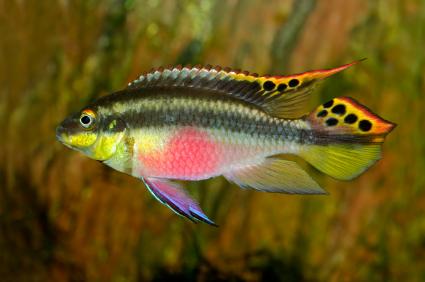Kribensis (Pelvicachromis pulcher)

Kribensis (Pelvicachromis pulcher) are very popular dwarf African cichlids. They are colorful, peaceful fish (except at breeding time) and they can even be kept in a community tank.
Their common name, Kribensis ( or Kribs for short) is derived from their former scientific name Pelmatochromis kribensis. They are also commonly referred to as purple cichlids.
As the name "African cichlid" suggests, they belong to the family Cichlidae, and are from West Africa (Nigeria).
Unlike a lot of African cichlids, Kribensis (Kribs) can be kept in a community tank. Their aquarium should have rocks and caves, and should be heavily planted.
Some resources state that you should keep them in brackish water, however, most aquarists feel they do best in freshwater.
Water temperature should be between 75-82° (24-28°). The pH should be slightly acidic to neutral (6.5-7.0) and their water should be soft to medium-hard.
They reach an adult size of about 3-4 inches (8-10 cm).
Kribensis will eat most aquarium fare, flakes, pellets, freeze-dried, frozen, and live foods. Feeding them meaty type foods will help to get them into breeding condition. In their natural habitat they eat worms, insects, small crustaceans, and plant material.
Sexing Kribensis
Sexing kribensis isn't too difficult. Males are much larger than females. Also, males have more pointed dorsal and anal fins than females do. Unlike most tropical fish, female kribensis are more colorful than the males.
However, males have more color on their caudal fin (tail) than females do. The upper part of the male's tail has a few dark spots surrounded by yellow. The kribensis in the photo at the top of this page is male. There is some variety in the coloration of kribensis.
Spawning and Care of Kribensis Fry
Spawning occurs in small caves or overturned clay flowerpots. The eggs will be deposited on the roof of the cave or clay pot.
You'll know when spawning is over because the male will leave the flowerpot or cave. He can be removed once spawning is over, however, unless the parents are fighting he can remain in the tank. Definitely leave the female in the tank. She will usually remain in the cave or clay pot with the eggs until they hatch. Often, both adult kribs will guard the eggs until they hatch about 48-36 hours later.
In about 3-4 days the fry will be free-swimming. The fry can take care of themselves at this point and you can remove the female fish (their mother) and the male fish if he is still in the tank. I like to leave the parents in with the free-swimming fry for a few days to watch them herd their fry around.
However, there is some risk of doing this - occasionally the adult kribs will eat the fry once they become free-swimming.
Once the fry are free-swimming feed them commercial liquid fry food or a small amount of hard boiled egg yolk squeezed through a cloth. In about 4-5 days start supplementing their diet with newly hatched brine shrimp and powdered fish food for fry.
A few research studies have shown that krib fry raised in water with an acidic pH resulted in mostly males, but that krib fry raised in water with a neutral or alkaline pH were mostly female (Barlow, 2000).
Barlow, G. W. (2000). The Cichlid Fishes. Perseus Publishing: Cambridge, MA.
